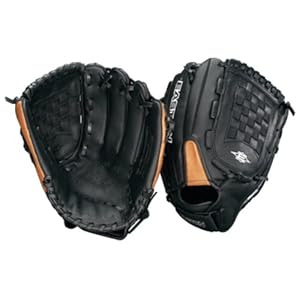 Amazon.com Baseball and Softball Glove Guide
Amazon.com Baseball and Softball Glove GuidePlaying the Field
Baseball and softball gloves are specially designed to suit the needs of the given field position, with each kind of glove boasting unique features to enhance a player's performance at his / her position. The following is often a brief summary of every glove's characteristics:
Catcher: No finger channels, with heavy palm padding and overall reinforcements to reduce the sting of repeatedly catching pitchers' throws
First Base: Also lacks finger channels, however with less padding that a catcher's mitt, with added length to help you catch infield throws and shallow pocket, enabling quick ball retrieval
Infield: Five-fingered glove has shallow pocket for fast ball retrieval, with nine- to 10-inch youth sizes and 10.5- to 11.5-inch adult sizes, and softball infield gloves creating a deeper pocket to accept the greater ball
Second base players require smaller gloves to balance control using the need to generate quick throws
Shortstops make usage of a mid-sized glove for ground balls and quick throws
Third base players need a larger glove for maximum catching power
Outfield: Glove is longer to offer extended reach, with an in-depth pocket to take care of high-lofting balls, and sizes range from 12 inches and up for adults and 11 inches for youth players
Softball Gloves: The characteristics, by position, of softball gloves are typically comparable to their baseball counterparts, with softball gloves having more length and deeper pockets to deal with the larger ball
Anatomy of the Glove
Gloves were created to perform a relatively simple task--catch a ball. The quality of materials and craftsmanship that can go into a building a glove, however, can be surprising. Below is surely an overview of a glove's components and the way each helps optimize your defensive game:
Pocket: Pocket depth is dependent upon player position, with shallower pockets helping infielders quickly retrieve and toss the ball, and outfielders' pocket depth aiding in capturing a ball on the fly. Softball players likewise need deeper pockets to trap the bigger ball.
Webbing: The most preferred webbing pattern is partly based on field position and partly by player preference. Generally, open webbing helps infielders quickly retrieve the ball, closed or tightly woven webbing gives outfielders and third basemen extra support, and closed webbing allows pitchers to cover up the ball in the batter.
Backs: The back of a glove, or part that goes over the top of your hand, can either be closed or open, that is largely a a few player preference. Some infielders find a back being more flexible and forgiving, while outfielders may as being a closed back with finger hole for added support.
Wrist Adjustment: Some gloves include fit systems, or wrist adjustments, to help keep your glove tightly affixed to your player's hand. Typically the most popular closures are buckles, D-rings, lacing, and Velcro.
Padding: How padded a glove's pocket is is determined by position, with catcher being one with the most heavily padded. In recent years, many manufacturers have did start to add padding along with other position gloves to reduce "palm shock."
Materials: By and large, gloves are constructed using considered one of three materials--leather, treated leather, or synthetic--with the differences relating to feel and durability.
Leather: Most high-end gloves are manufactured from leather, that offers optimal feel and durability, with leather quality being a substantial cost driver
Treated Leather: Leather material is softened and strengthened during production for quicker break-in, better durability, minimizing maintenance
Synthetic: A lower-cost option to leather that provides reduced durability and responsiveness, and is really a good choice for beginning players
Fits Like a...
As mentioned above, age and position would be the most significant factors in selecting an effective glove size. Outfielders need larger gloves with deeper pockets for max "catchability," while infield gloves are smaller and possess shallower pockets for optimal control and speedy ball removal. Some pitchers opt for infield gloves which can be slightly greater than standard, yet small and shallow enough for rapid fielding and throwing. Most younger players will benefit from youth-sized gloves that assist with control, and it is a good idea to resist the temptation to purchase a bigger glove the kid will grow into.
The tables below provide a general guideline for proper glove size by sport, position, and age.
Baseball Glove Size
Age Position Glove Size
Under 8 Infield 9"
Under 8 Outfield 11"
9-13 Infield 9-10"
9-13 Outfield 11-12"
13 and older Infield 10.5-11.5"
13 and older Outfield 12-12.75"
Softball Glove Size
Age Position Glove Size
6 and under All 9-10"
7-9 All 10-11.5"
10-14 Infield 11.5-12.5"
10-14 Outfield 12-13"
15 and older Infield 12-13"
15 and older Outfield 12.5-14"
Ideal fit system

List Price: $29.99
Price: $27.95 & this item ships for FREE with Super Saver Shipping. Details
You Save: $2.04 (7%)
Product Features
Lock down velcro strap
Baseball / Softball patterns
Leather laces Baseball Glove
Embroidered logo Baseball Glove
Contoured index finger pad
 More About ___
More About ___Easton BX1400B Baseball Glove (14-Inch)
No comments:
Post a Comment